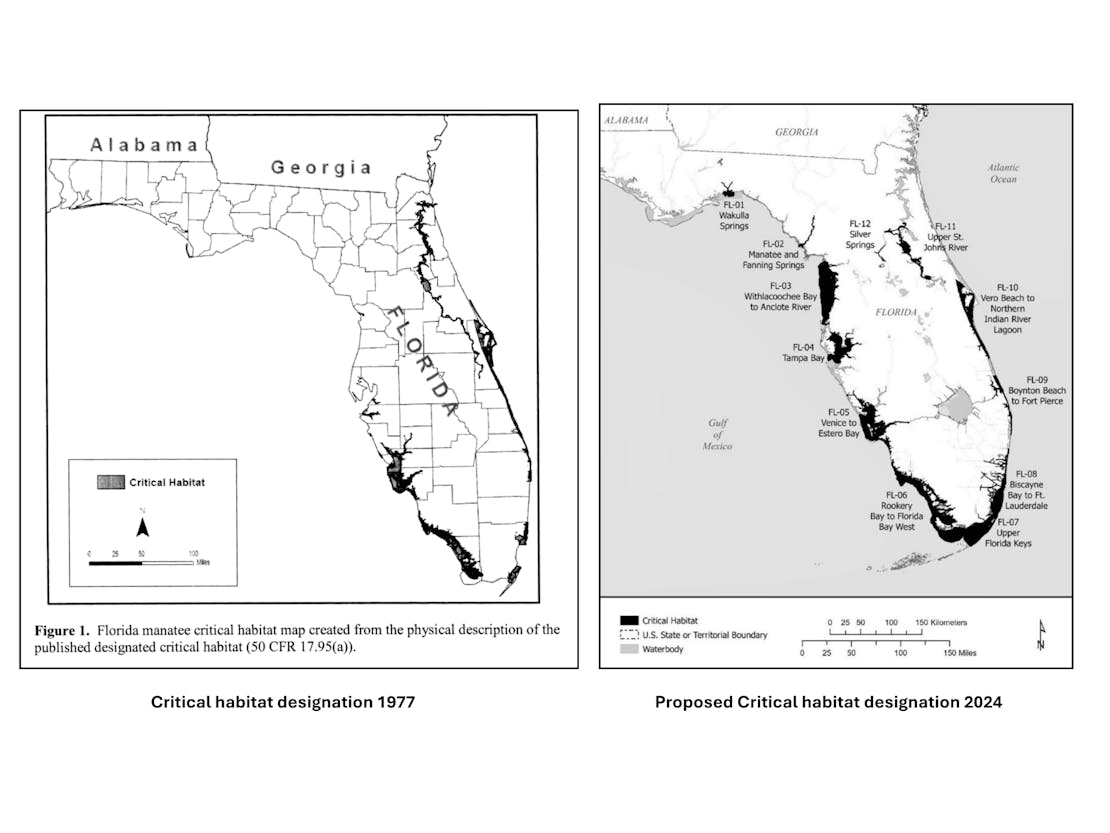Picture a gray, round marine mammal swimming through the water munching on aquatic vegetation. Occasionally a slightly hairy snout breaks the water’s surface for air. This Florida manatee, a subspecies of the West Indian manatee, was spotted on a waterway in Florida.
Florida manatees live in the warm coastal waters of the southeastern United States and can be found as far west as Texas and as far north as Massachusetts during the heat of the summer. Manatees return to the most predictable and consistently warm waters in the Sunshine state during the winter, congregating in large groups of up to 2,500 individuals!
The beloved and threatened manatee has a unique set of behaviors for keeping themselves warm and fed year-round. Humans have shaped some of those behaviors, however, much to the detriment of these animals.
During the coldest months of year — mid-November through March — manatees require warm water, like natural springs, that have water temperatures near 72 degrees Fahrenheit. Despite their rotund shape and that they eat 10% of their body weight in plant matter every day (that’s like a 150-pound adult eating 15 pounds of veggies in 24 hours!), manatees lack blubber and the ability to thermoregulate.
Major alterations to their habitats, particularly during the cold season, have led us to ask the questions: What habitat is most needed for them now? And how can we find safe, lasting places for them to live for decades to come? Read on to gain a greater understanding of the manatee’s history and how we are trying to answer these questions.
The Need for a Renovation
Historic hunting pressure, habitat loss and vulnerability to boat collisions (which is still a major cause of manatee deaths today) led to West Indian manatees receiving special protections from the U.S. government as early as 1967 and listing under the Endangered Species Act in 1973. In 1976, the U.S. Fish and Wildlife Service looked at where manatees congregated along coasts and in bays, springs and rivers. These areas were identified as ‘critical habitat’, signaling them as the most important areas for these majestic creatures’ survival at the time.
Unfortunately for the manatees, that is where an in-depth look at their habitat ended.
Addressing the Gaps and Filling in the Holes
As groovy as the 1970s were, the ‘physical and biological features’ necessary for manatee recovery were not outlined in 1976. These features include reliable food — including special shallow water grasses and plants — and nearby warm waters for manatees to survive the winter months. Without these features, and others, manatees are likely to further decline in numbers.
On September 24, 2024, FWS proposed new critical habitat regulations that consider these needs, but they don’t fully address how much the landscape has changed for these vulnerable mammals over the past 50 years. We may have ditched the “shag carpet,” but we laid down three unsustainable surfaces in their place.
1. We unintentionally created a situation where manatees need the warm water created by power plants to stay alive in cold weather. Over half of Florida’s manatees rely on power plants to survive the winter months. Mothers teach their calves to return to these warm sites year after year, creating a dependence on the balmy waters produced by the power plants into surrounding waterways. Once these power plants go offline, these manatees will have limited options.
2. We have also reduced their food sources food by polluting our waters with run-off, fertilizers, leaking septic tanks and sewage, in turn causing multiple algae species to thrive (some are toxic), while eel grasses and other submerged plants die off. These seagrass losses have led to longer distances between warm water and healthy grasses, and many manatee deaths.
In 2021, a record 1,100 manatees died. An unprecedented number perished due to starvation from lack of healthy food sources, especially in the Indian River Lagoon. This led the FWS to declare an unusual mortality event (UME) for Florida manatees along the East Coast of Florida. While manatees are still in trouble, conditions are improving after major inventions and resources were provided.
3. Massive development along Florida’s coastlines has also shifted manatee’s habitats. Most of Florida’s coastlines have been dredged, filled or built upon. Dams have been constructed in other areas, blocking manatee access to natural warm water and additional food sources.
With all these human-caused changes to Florida’s waterways, the manatee is left with few choices on where to go.
Natural, warm, clear and free-flowing springs are the best winter habitat for manatees. Springs and other natural waterways like thermal basins provide an alternative to power plant outfalls. Unfortunately, manatees require our help to restore these areas and provide them with additional alternatives where springs are absent or too degraded to be useful as habitat. This isn’t a new problem, but it will require some new solutions including restoring spring health and access.
A Modern Approach Required
The 2024 critical habitat proposal now includes some important springs for manatee recovery including Silver Springs, Manatee Springs and Fanning Springs. It doesn’t, however, factor in where the healthiest, most available grasses are now and where larger die-offs are likely to happen due to human development and pollution.
The designation also excludes parts of the Mosquito Lagoon, which was an important place for manatees to find food during the unprecedented die-off of Florida manatees during the on-going UME. This entire system needs to be included in the critical habitat designation because it is essential to supporting manatees’ basic survival needs.
Finally, the 2024 proposal does not include a connected, free-flowing Ocklawaha River in Northcentral Florida. This River contains 20 artificially flooded springs, which could be excellent manatee habitat if it were accessible and restored.
How You Can Help
You can help protect manatees and the habitat they need to recover by joining us in telling FWS to include additional areas in their proposed revisions to the critical habitat designation! Sign this letter, which advocates for more comprehensive, essential habitat for Florida manatees.
Also, anyone who sees an injured, distressed, sick or dead manatee should report it to the Florida Fish and Wildlife’s Wildlife Alert Hotline at 888-404-FWCC (3922) so that trained responders can assist.














Follow Defenders of Wildlife
facebook bluesky twitter instagram youtube tiktok threads linkedin